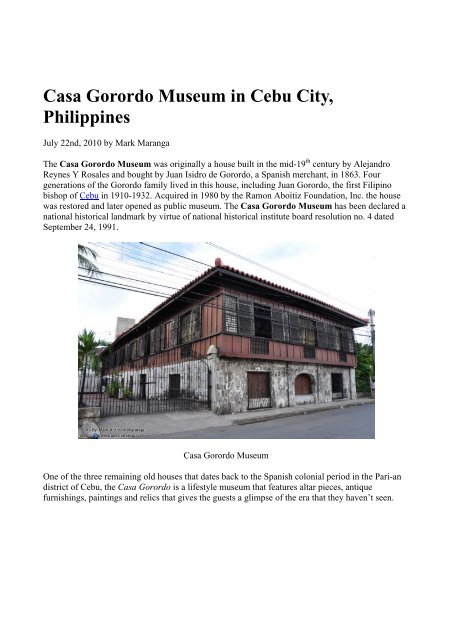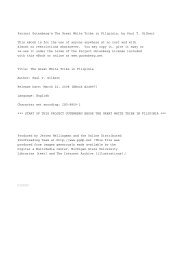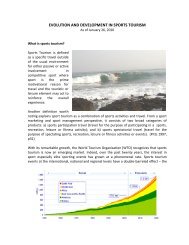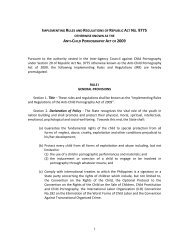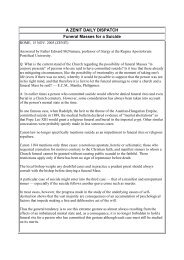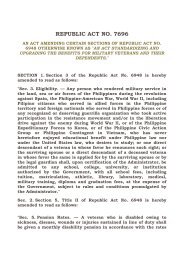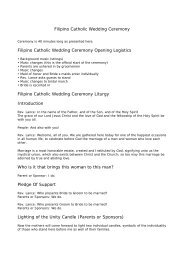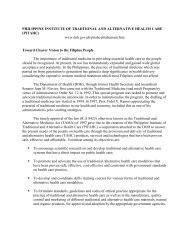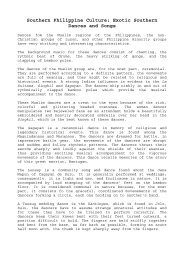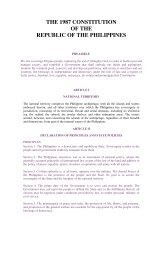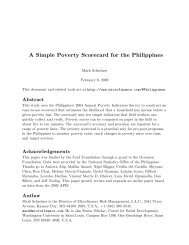Casa Gorordo Museum in Cebu City, Philippines
Casa Gorordo Museum in Cebu City, Philippines
Casa Gorordo Museum in Cebu City, Philippines
Create successful ePaper yourself
Turn your PDF publications into a flip-book with our unique Google optimized e-Paper software.
<strong>Casa</strong> <strong>Gorordo</strong> <strong>Museum</strong> <strong>in</strong> <strong>Cebu</strong> <strong>City</strong>,<br />
Philipp<strong>in</strong>es<br />
July 22nd, 2010 by Mark Maranga<br />
The <strong>Casa</strong> <strong>Gorordo</strong> <strong>Museum</strong> was orig<strong>in</strong>ally a house built <strong>in</strong> the mid-19 th century by Alejandro<br />
Reynes Y Rosales and bought by Juan Isidro de <strong>Gorordo</strong>, a Spanish merchant, <strong>in</strong> 1863. Four<br />
generations of the <strong>Gorordo</strong> family lived <strong>in</strong> this house, <strong>in</strong>clud<strong>in</strong>g Juan <strong>Gorordo</strong>, the first Filip<strong>in</strong>o<br />
bishop of <strong>Cebu</strong> <strong>in</strong> 1910-1932. Acquired <strong>in</strong> 1980 by the Ramon Aboitiz Foundation, Inc. the house<br />
was restored and later opened as public museum. The <strong>Casa</strong> <strong>Gorordo</strong> <strong>Museum</strong> has been declared a<br />
national historical landmark by virtue of national historical <strong>in</strong>stitute board resolution no. 4 dated<br />
September 24, 1991.<br />
<strong>Casa</strong> <strong>Gorordo</strong> <strong>Museum</strong><br />
One of the three rema<strong>in</strong><strong>in</strong>g old houses that dates back to the Spanish colonial period <strong>in</strong> the Pari-an<br />
district of <strong>Cebu</strong>, the <strong>Casa</strong> <strong>Gorordo</strong> is a lifestyle museum that features altar pieces, antique<br />
furnish<strong>in</strong>gs, pa<strong>in</strong>t<strong>in</strong>gs and relics that gives the guests a glimpse of the era that they haven’t seen.
<strong>Casa</strong> <strong>Gorordo</strong> Marker<br />
The lower floor of the <strong>Casa</strong> <strong>Gorordo</strong> <strong>Museum</strong> traditionally served as storage space. It now houses<br />
the offices of the museum, an area for the art exhibitions and a small store. The house is built us<strong>in</strong>g<br />
the massive and tough coral stones, which most century-old establishments are built from. It has a<br />
roof made from tisa clay which weighs around 1 kilogram each piece. The second story has wooden<br />
floors and housed the antique furniture, costumes, books and memorabilia from the past.<br />
Noteworthy is the master’s bedroom that displays the collection of “sayas”. A small room found <strong>in</strong><br />
the residence was used as a chapel whenever Bishop Juan <strong>Gorordo</strong> visits the house. The chapel<br />
displays a “pasyon” manuscript <strong>in</strong> <strong>Cebu</strong>ano.
Front of <strong>Casa</strong> <strong>Gorordo</strong><br />
A typical balcony that runs the whole length of the d<strong>in</strong><strong>in</strong>g room and kitchen is visible from the<br />
garden. The d<strong>in</strong><strong>in</strong>g room is separated from the liv<strong>in</strong>g room by an arch ornately carved with plants<br />
and birds. The garden is full of bouga<strong>in</strong>villea and has been religiously landscaped. A new service<br />
build<strong>in</strong>g, <strong>in</strong>spired by 19th century architecture, has been built beside <strong>Casa</strong> <strong>Gorordo</strong> <strong>Museum</strong>.<br />
Situated <strong>in</strong> 35 Lopez Jaena St., <strong>Cebu</strong> <strong>in</strong> the Philipp<strong>in</strong>es and a hundred of meters away from the Yap-<br />
Sandiego Ancestral House, the <strong>Casa</strong> <strong>Gorordo</strong> <strong>Museum</strong> entices locals and foreigners alike. Both<br />
adults and children visit the place for a glance at Philipp<strong>in</strong>es’ history and wonders. It is a 4 m<strong>in</strong>utes<br />
walk from the <strong>Cebu</strong> Heritage monument and 5 m<strong>in</strong>utes walk from Colon Street Marker: the oldest<br />
street <strong>in</strong> the Philipp<strong>in</strong>es.<br />
19th-century <strong>in</strong>spired service build<strong>in</strong>g
To get there, one needs to take a jeepney go<strong>in</strong>g to Colon. There are very less jeepney that passes<br />
along <strong>Casa</strong> <strong>Gorordo</strong> <strong>Museum</strong> so the best option is to stop by the Colon Street Marker and ask<br />
locals for the location. Just be sure to ask the driver first before tak<strong>in</strong>g the ride if he is go<strong>in</strong>g to the<br />
marker. Alternatively, you can take a taxi to go directly to the place.<br />
Interior of the the museum<br />
<strong>Casa</strong> <strong>Gorordo</strong> <strong>Museum</strong> is open from Tuesday-Sunday from 10am-6pm. Admission fee is P70 for<br />
foreigners, P40 for adults (locals) and P15 for students (locals). You may contact them at<br />
(+63)(32)418-7234 loc 532 for reservation and more <strong>in</strong>formation.<br />
Ref.: http://www.markmaranga.com/casa-gorordo-museum-<strong>in</strong>-cebu-city-philipp<strong>in</strong>es/


